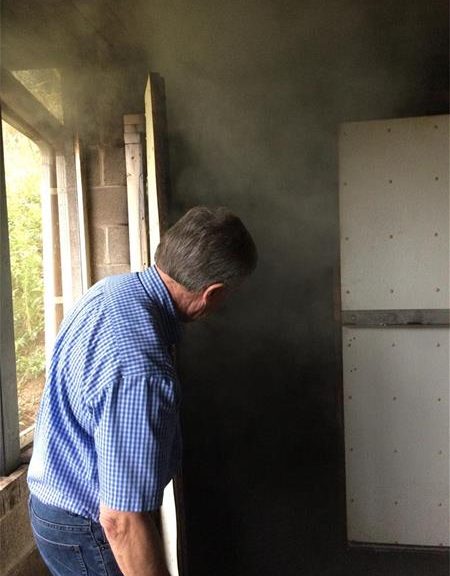Allan Benton’s bacon is powerful. Salty, smoky stuff, it’s by far the most intense bacon we sell. After tasting it for the first time, I imagined Allan Benton to be a big, burly guy, with thick, tattooed forearms and a bushy beard. But as the old adage goes, never judge a smoker by his bacon. Allan is slender, seventy-ish, with a charming, humble demeanor and a crack sense of humor. How did such a gentle guy come to make such a robust bacon?
Allan grew up in the backcountry hills of western Virginia.
Growing up, his family—like all the families around him—grew essentially all of their own food, including raising their own pigs. As Allan describes it, “All our food was local because we grew it ourselves. All our food was heirloom because we grew it from our own seeds. And all our food was organic, because we didn’t have any fertilizers or pesticides to use on it.” Every year on Thanksgiving Day, the neighbors would get together to kill and butcher the hogs. In order to have meat all year long they’d cure and smoke the cuts. The family smokehouse still stands out back behind the house Allan grew up in.
Like so many people I’ve met in the food world, Allan didn’t set out to do what he does. He started his career as a teacher. After getting his master’s in psychology he planned to become a guidance counsellor. As it turned out, though, the pay for teachers and guidance counsellors in eastern Tennessee was too low for Allan to be able to support his family. Around the same time, he learned that a nearby ham smoker and curer named Albert Hicks was ready to retire. Allan bought Albert’s business, and for the last 45 years he’s made hams and bacon like the ones he grew up eating.
People often ask Allan what the “secret” is to making his bacon.
He’s quick to answer in his unassuming, soft spoken way. “The secret is that there is no secret. This is just the way bacon was made years ago.”
Allan starts with heritage breed pork from small farms—some nearby in eastern Tennessee, some further afield in the US. His favorite breed is Duroc, though he’s tried and used many breeds over the years. Heritage breeds tend to have better flavor. Unlike modern pigs raised in confinement to grow as quickly as possible, heritage breeds grow more slowly and were selected for their excellent fat, or hardiness, or exceptional flavor—or all three.
To make his bacon, Allan cures the heritage pork bellies in a mix of salt and brown sugar. He covers them in just enough salt; he told me once, “bellies are delicate, you can overdo it.” The bellies spend ten days in the salt. Being cured directly in salt is called “dry curing,” to distinguish it from “wet curing,” where the bellies are cured in a salty brine. Dry curing tends to draw more water out of the bellies, concentrating the flavor more deeply.
After the ten days in the salt, the bellies hang in a cool space for ten days, and after that they hang at ambient temperature for another ten days. During all of this time, the bellies are losing moisture, making them inhospitable to bacteria, and therefore safe to keep—even at room temperature—for weeks and months to come. Finally, the bellies spend three to four days smoking over hickory. Compared to sweet applewood, hickory tends to impart a more savory aroma and flavor—I think of it as the smell of a campfire.
The thirty days of curing and four days of smoking is longer than any other bacon I know of. Industrially produced bacon gets churned out in just a few hours. Even other artisan bacons generally take a week or two at most to cure, and smoking rarely takes more than a day. The longer cure and smoke makes a huge difference. Allan’s bacon is the saltiest, smokiest, most intense bacon I’ve ever tasted. It can be polarizing. People either love it, or they think it’s way too much.
Once, a chef came to Allan and asked if he would adjust his recipe.
He asked whether Allan would consider making a batch of bacon special for him, smoking it for just one day so that the flavor would be a little less intense? Allan thought it over. It just didn’t feel true to who he was and the food he made. After a few days, he thanked the chef for his interest, but told him that he wouldn’t make the special recipe. “But luckily,” Allan told me with a twinkle in his kind, blue eyes, “he bought my bacon anyway.”
That chef who wanted a milder Benton’s bacon was definitely the exception, not the rule. Allan’s bacon has been lauded by everyone from chefs David Chang at Momofuku and Sean Brock at Husk, to the New York Times.
You could fry up a rasher of Benton’s bacon.
It would be great alongside eggs or pancakes like any other bacon. But with such an intensely savory flavor, I think Benton’s really shines as a base ingredient in all kinds of dishes. It adds a crazy depth of smoky flavor to pasta carbonara. It packs a powerful punch atop a wilted spinach salad. It’ll stand up to a smoky, chargrilled burger with clothbound cheddar or a good smear of blue cheese. But maybe the best way of all to eat it is chopped into bits on top of a bowl of really good grits—or, to make it even more decadent, make it a bowl of exceptional shrimp and grits.

